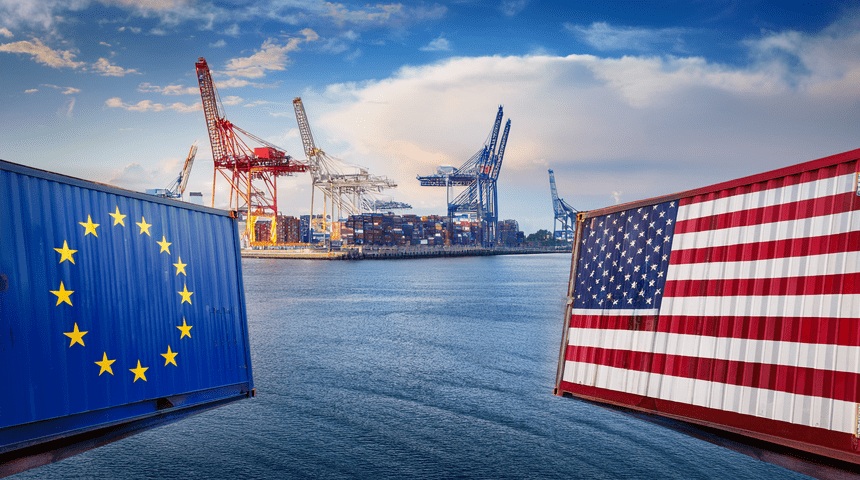European Exporters Face A Heavy Blow as Trump Tariffs Loom, Trade Talks Falter

European firms are bracing for a heavy blow as President Donald Trump pushes ahead with sweeping tariffs on EU goods, intensifying trade tensions and threatening to derail key industries across the continent.
With just days to go before the U.S. imposes a 30% tariff on all European imports starting August 1, European officials are scrambling to reach a last-minute agreement to stave off the economic fallout.
Trump’s move follows a series of aggressive trade actions, including a 25% duty on foreign vehicles and parts imposed in April, bringing the effective U.S. tariff on European autos to 27.5%. The president has since threatened to raise this to 30%, sending shockwaves through Europe’s manufacturing and export sectors, particularly the already struggling auto industry.
Register for Tekedia Mini-MBA edition 18 (Sep 15 – Dec 6, 2025) today for early bird discounts. Do annual for access to Blucera.com.
Tekedia AI in Business Masterclass opens registrations.
Join Tekedia Capital Syndicate and co-invest in great global startups.
Register for Tekedia AI Lab: From Technical Design to Deployment.
Auto Industry Hit Hard
German auto giant Volkswagen reported a €1.3 billion ($1.53 billion) hit from U.S. tariffs in just the first half of 2025. Its Q2 earnings showed a sharp drop in operating profit, prompting the company to slash its full-year guidance.
Similarly, Stellantis, the multinational automaker behind brands like Jeep, Dodge, and Peugeot, pre-emptively warned investors of a €2.3 billion loss, citing tariffs and production delays. The group confirmed a €300 million loss in H1 from direct tariff costs and output disruptions triggered by trade uncertainty.
Swedish automaker Volvo Cars also posted a steep fall in Q2 operating profit, attributing the downturn directly to the White House’s tariff regime.
Consumer and Tech Firms Also Struggling
The economic toll isn’t limited to automakers. German sportswear brand Puma issued a profit warning Friday, saying U.S. trade policy had depressed sales and would likely lead to a full-year operating loss. Before the warning, Puma had projected a profit between €445 million and €525 million.
In France, spirits maker Rémy Cointreau raised its full-year guidance but admitted U.S. tariffs would weigh more heavily than anticipated, now projecting a €35 million tariff hit, up from its previous estimate of €25 million.
Nokia, the Finnish telecom equipment giant, cited tariffs as a key reason for slashing its full-year operating profit forecast to between €1.6 billion and €2.1 billion, down from €1.9 billion to €2.4 billion. Tariffs are expected to reduce Nokia’s 2025 earnings by as much as €80 million ($94 million).
Truck manufacturer Traton, a Volkswagen subsidiary, cut its 2025 revenue outlook, citing a dramatic slowdown in the North American market caused by rising tariffs. The company now expects sales to drop by up to 10%, down from a previous forecast that ranged from a 5% fall to a 5% increase. Traton warned that it hasn’t even priced in the possibility of additional 50% tariffs on Brazilian goods or a full 30% EU-wide levy.
Trade Talks: A 50/50 Gamble
Speaking to reporters Friday before departing for Scotland, President Trump said there was a “50/50 chance, maybe less” of a deal being reached with the European Union. EU Commission President Ursula von der Leyen is expected to meet Trump this Sunday in Scotland to discuss the escalating trade rift.
Despite a flurry of meetings and behind-the-scenes diplomacy, negotiators have failed to secure a pact. EU officials are reportedly considering a baseline 15% tariff compromise that might exempt some critical industries. But with the deadline looming, the European bloc is preparing countermeasures worth €93 billion ($109 billion) targeting a wide range of U.S. goods, effective August 7 if no deal is struck.
Global Trade Fractures
Trump’s tariff push isn’t limited to Europe. He has already enacted trade pacts with Britain, Japan, and the Philippines, but his administration’s “90 deals in 90 days” promise has so far yielded just five partial agreements.
Talks with Canada have stalled. Trump threatened to slap 35% tariffs on Canadian imports if Ottawa doesn’t agree to U.S. terms.
“We haven’t had a lot of luck with Canada,” Trump said.
He claimed many of the “deals” he referenced were actually notification letters to foreign governments about pending tariffs, not negotiated agreements.
Companies across Europe are now revisiting their forecasts, many of which were based on assumptions that the 30% tariffs would not materialize or that the EU would refrain from retaliating. Thales, the French aerospace and defense group, currently anticipates a limited direct impact from U.S. tariffs. However, its outlook assumes just 10% tariffs, well below what Trump is threatening.
In a Friday note to clients, Citi economists said early data shows European exporters are absorbing the tariff costs to maintain competitiveness, rather than passing them to consumers. Still, the impact is expected to feed through the system in the coming quarters. Citi now projects 0% core goods inflation in the eurozone in 2026 due to “disinflationary effects” — driven by lower Chinese import prices and a strengthening euro.
Currently, the only certainty is volatility. With the August 1 deadline approaching, investors, companies, and policymakers are watching closely to see whether Trump’s hardline strategy will result in a last-minute truce or trigger a full-blown transatlantic trade war.
Von der Leyen’s meeting with Trump this weekend may be Europe’s last chance to prevent a crisis.


